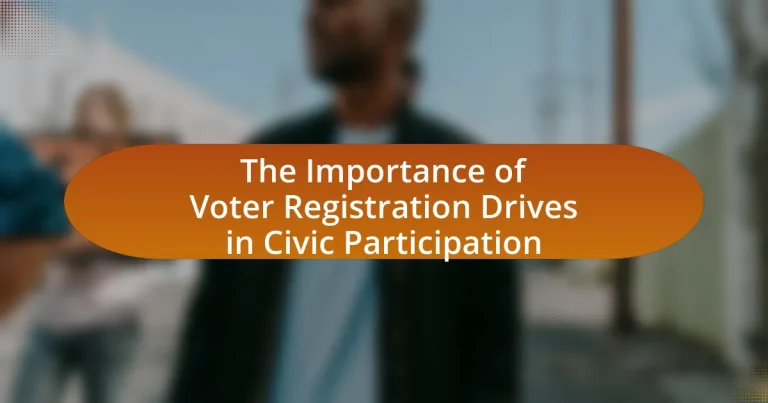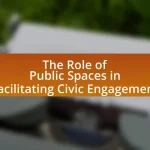Voter registration drives are organized initiatives aimed at increasing the registration of eligible voters, which is crucial for enhancing civic participation and ensuring diverse representation in democratic processes. These drives function by providing information, assistance, and resources to potential voters, significantly improving turnout rates, particularly among underrepresented populations. The article outlines the steps involved in organizing effective voter registration drives, the challenges faced, and successful strategies for overcoming obstacles, including the use of technology and community partnerships. Additionally, it emphasizes the importance of civic engagement for a healthy democracy and provides insights into best practices for maximizing outreach and measuring success in voter registration efforts.
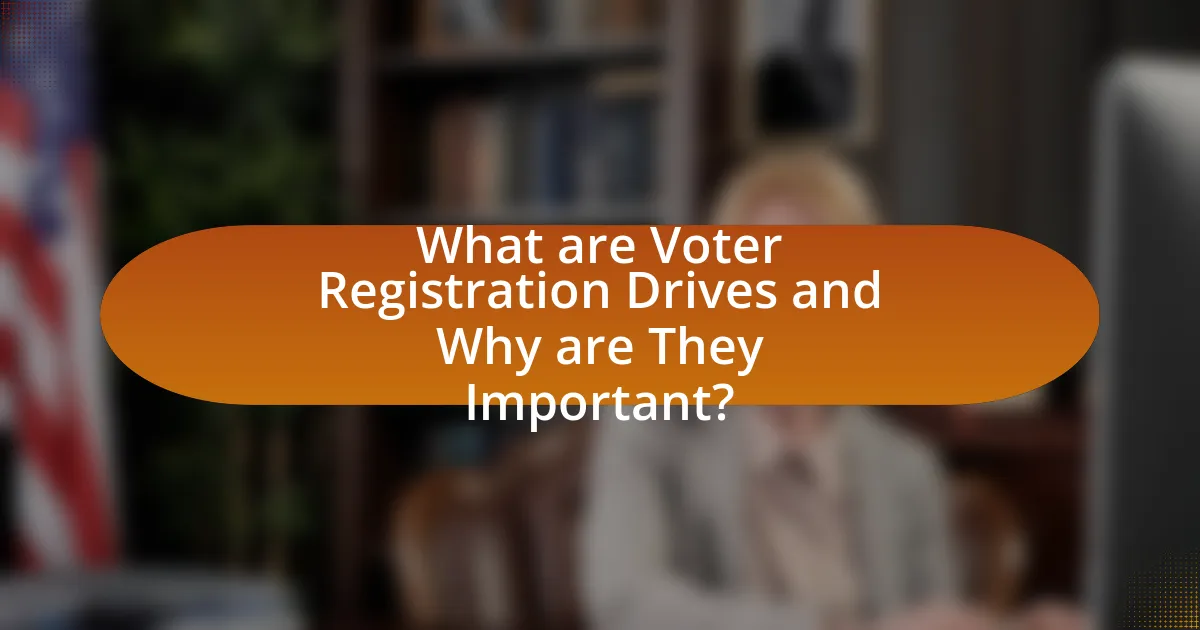
What are Voter Registration Drives and Why are They Important?
Voter registration drives are organized efforts aimed at encouraging and facilitating the registration of eligible voters. These drives are important because they increase voter participation, which is essential for a healthy democracy. According to the U.S. Census Bureau, higher voter registration rates correlate with increased turnout in elections, demonstrating that these drives effectively mobilize citizens to engage in the electoral process. By making registration more accessible, voter registration drives help ensure that diverse voices are represented in decision-making, thereby strengthening civic participation and promoting equitable political representation.
How do Voter Registration Drives function in the electoral process?
Voter registration drives function by actively facilitating the registration of eligible voters, thereby increasing participation in the electoral process. These drives typically involve organizations or volunteers who set up events or campaigns to inform individuals about the registration process, provide assistance in completing registration forms, and ensure that the completed forms are submitted to the appropriate election authorities. According to the U.S. Census Bureau, states that implemented voter registration drives saw a significant increase in voter turnout, with some studies indicating that participation rates can rise by as much as 10% in areas where these drives are conducted. This demonstrates the effectiveness of voter registration drives in enhancing civic engagement and ensuring that more citizens have the opportunity to exercise their right to vote.
What steps are involved in organizing a Voter Registration Drive?
To organize a Voter Registration Drive, the following steps are involved: first, identify the target audience and location for the drive, ensuring it aligns with community needs. Next, secure necessary permits and permissions from local authorities to conduct the event legally. Then, gather materials such as registration forms, informational brochures, and promotional items to attract participants. Following this, recruit and train volunteers to assist with the registration process and provide information to attendees. Promote the event through various channels, including social media, local newspapers, and community bulletin boards, to maximize outreach. Finally, execute the drive on the scheduled date, ensuring that all participants are assisted in completing their voter registration forms accurately. These steps are essential for effectively increasing voter registration and enhancing civic participation in the electoral process.
Who typically leads Voter Registration Drives?
Voter registration drives are typically led by community organizations, non-profit groups, and political parties. These entities mobilize volunteers and resources to encourage voter participation and ensure that eligible individuals are registered to vote. For instance, organizations like the League of Women Voters and Rock the Vote have historically played significant roles in leading such initiatives, often targeting underrepresented populations to enhance civic engagement.
What role do Voter Registration Drives play in increasing civic participation?
Voter Registration Drives significantly enhance civic participation by facilitating access to the electoral process for underrepresented populations. These drives actively engage communities, often targeting individuals who may face barriers to registration, such as low-income citizens or young voters. Research indicates that states implementing robust voter registration initiatives see higher turnout rates; for example, a study by the U.S. Census Bureau found that states with same-day registration had turnout rates approximately 10% higher than those without. This evidence underscores the effectiveness of voter registration drives in mobilizing citizens to participate in elections, thereby strengthening democratic engagement.
How do these drives impact voter turnout?
Voter registration drives significantly increase voter turnout by facilitating access to the electoral process. Research indicates that states implementing robust voter registration initiatives see turnout rates rise by as much as 10-15%. For example, a study by the National Bureau of Economic Research found that automatic voter registration in certain states led to a 7% increase in participation among eligible voters. These drives remove barriers to registration, making it easier for individuals to engage in elections, thereby enhancing overall civic participation.
Why is civic engagement crucial for a healthy democracy?
Civic engagement is crucial for a healthy democracy because it fosters active participation in the political process, ensuring that citizens have a voice in governance. When individuals engage in civic activities, such as voting, attending town hall meetings, or participating in community organizations, they contribute to a more representative and responsive government. Research indicates that higher levels of civic engagement correlate with increased voter turnout and stronger democratic institutions. For instance, a study by the Pew Research Center found that communities with robust civic engagement initiatives experience greater political efficacy and trust in government, leading to more effective policy outcomes.
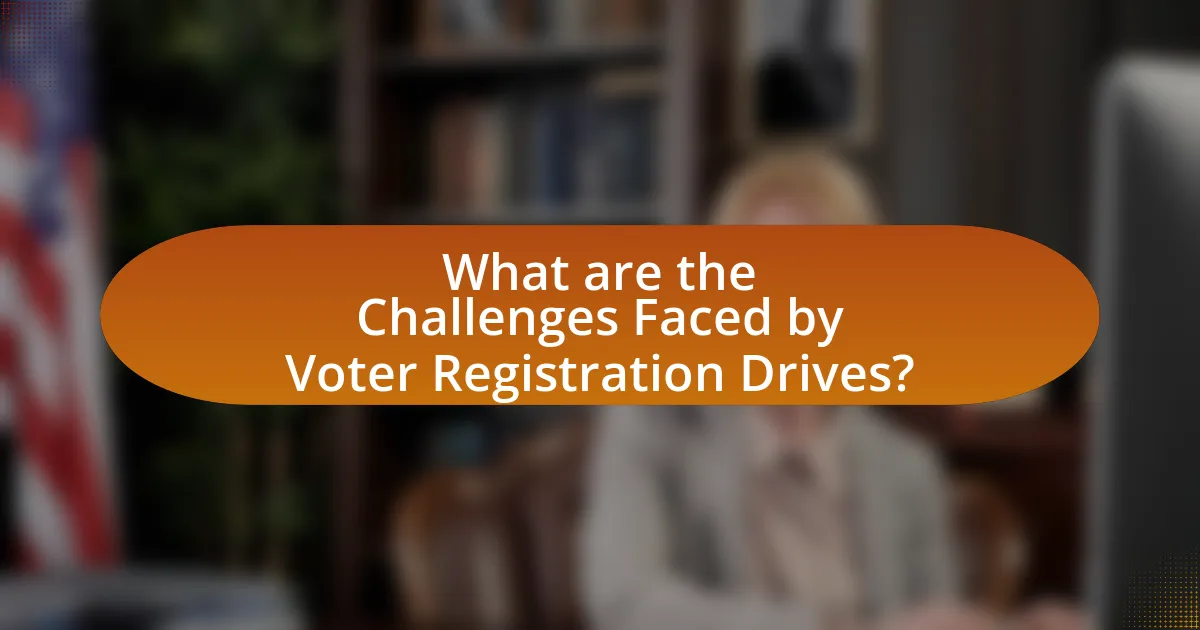
What are the Challenges Faced by Voter Registration Drives?
Voter registration drives face several challenges that hinder their effectiveness. One significant challenge is the lack of awareness among potential voters about the registration process, which can lead to lower participation rates. According to the U.S. Census Bureau, in the 2020 election, approximately 30% of eligible voters did not register, often due to confusion or misinformation regarding registration requirements. Another challenge is the accessibility of registration locations, particularly in rural or underserved urban areas, where potential voters may have difficulty reaching registration sites. Additionally, bureaucratic hurdles, such as complex paperwork and varying state laws, can discourage individuals from completing their registration. These factors collectively contribute to the difficulties faced by voter registration drives in promoting civic participation.
What obstacles hinder the effectiveness of Voter Registration Drives?
Obstacles that hinder the effectiveness of Voter Registration Drives include lack of awareness, bureaucratic barriers, and limited access to technology. Lack of awareness results in potential voters not knowing when or where registration drives occur, which can significantly reduce participation rates. Bureaucratic barriers, such as complex registration processes and varying state laws, can discourage individuals from completing their registration. Additionally, limited access to technology, particularly in underserved communities, restricts online registration options, further impeding voter registration efforts. According to the U.S. Census Bureau, in the 2020 election, approximately 17 million eligible citizens were not registered to vote, highlighting the impact of these obstacles on civic participation.
How do misinformation and apathy affect voter registration efforts?
Misinformation and apathy significantly hinder voter registration efforts by creating confusion and disengagement among potential voters. Misinformation, such as false claims about registration deadlines or eligibility requirements, can lead individuals to believe they are ineligible or that their participation is futile. A study by the Pew Research Center found that 40% of Americans reported encountering misleading information about voting, which directly correlates with lower registration rates. Apathy, characterized by a lack of interest or motivation to participate in the electoral process, further exacerbates this issue; individuals who feel disconnected from political outcomes are less likely to register. According to the U.S. Census Bureau, in the 2020 election, only 66.8% of eligible voters registered, with many citing disinterest as a primary reason for not participating. Together, misinformation and apathy create a barrier to effective voter registration, undermining civic engagement and participation in democracy.
What legal or logistical barriers exist for organizing these drives?
Legal and logistical barriers for organizing voter registration drives include compliance with state laws, obtaining necessary permits, and ensuring access to targeted populations. Each state has specific regulations governing voter registration efforts, which can vary significantly; for example, some states require organizations to register as official voter registration agencies. Additionally, logistical challenges such as securing locations for drives, coordinating volunteers, and reaching underrepresented communities can hinder efforts. According to the National Association of Secretaries of State, these barriers can lead to decreased participation in the electoral process, emphasizing the need for clear guidelines and support for organizations conducting these drives.
How can these challenges be overcome?
To overcome challenges in voter registration drives, targeted outreach and education initiatives must be implemented. These initiatives can include partnerships with community organizations to raise awareness about the registration process and its importance, as evidenced by studies showing that community-led efforts increase registration rates by up to 20%. Additionally, simplifying the registration process through online platforms and mobile registration units can address accessibility issues, as demonstrated by states that have adopted these methods, resulting in higher participation rates.
What strategies have proven successful in enhancing voter registration?
Successful strategies for enhancing voter registration include implementing automatic voter registration, outreach programs targeting underrepresented communities, and simplifying the registration process. Automatic voter registration, as seen in states like California, has increased registration rates significantly by automatically enrolling eligible citizens when they interact with government agencies. Outreach programs, such as those conducted by organizations like Rock the Vote, effectively engage young voters and minorities, leading to higher registration numbers. Additionally, simplifying the registration process through online platforms and same-day registration has proven effective; for instance, states that allow same-day registration have seen up to 10% higher turnout rates, according to research by the National Conference of State Legislatures.
How can community partnerships strengthen Voter Registration Drives?
Community partnerships can strengthen voter registration drives by leveraging local resources, networks, and trust within the community. These partnerships enable organizations to reach a broader audience, as they can utilize established relationships to engage individuals who may be less likely to register on their own. For instance, studies show that community-based organizations can increase voter registration rates by up to 20% through targeted outreach efforts. Additionally, partnerships with schools, faith-based organizations, and local businesses can provide venues for registration events, making the process more accessible and convenient for potential voters.
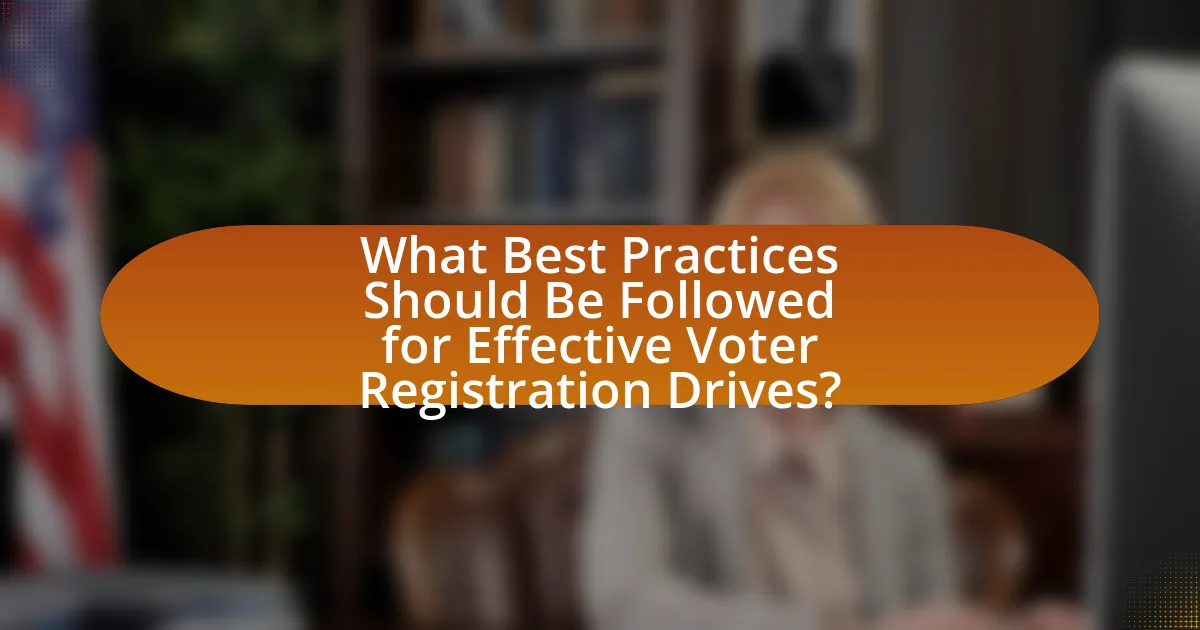
What Best Practices Should Be Followed for Effective Voter Registration Drives?
Effective voter registration drives should prioritize outreach, accessibility, and education. Outreach involves targeting diverse communities through various channels, such as social media, local events, and partnerships with community organizations, which can increase participation rates. Accessibility includes providing registration options in multiple languages and ensuring that registration sites are physically accessible to all individuals, including those with disabilities. Education focuses on informing potential voters about the registration process, deadlines, and the importance of voting, which can be supported by data showing that informed voters are more likely to register and participate in elections. For instance, the U.S. Census Bureau reported that in the 2020 election, states with proactive voter registration initiatives saw higher registration and turnout rates.
What methods can be employed to maximize outreach and engagement?
To maximize outreach and engagement in voter registration drives, employing targeted communication strategies is essential. Utilizing data analytics to identify demographics and tailoring messages to resonate with specific groups can significantly enhance participation rates. For instance, research from the Pew Research Center indicates that personalized outreach efforts can increase voter registration by up to 20%. Additionally, leveraging social media platforms for campaigns allows for broader reach and real-time interaction, fostering a sense of community and urgency around registration deadlines. Engaging local organizations and influencers can also amplify efforts, as they often have established trust within their communities, leading to higher engagement levels.
How can technology be leveraged in Voter Registration Drives?
Technology can be leveraged in voter registration drives by utilizing online platforms and mobile applications to streamline the registration process. These digital tools enable individuals to register easily from their devices, increasing accessibility and participation. For instance, states that implemented online voter registration saw a significant increase in registration rates; Arizona reported a 44% increase in registrations after introducing this system. Additionally, social media campaigns can raise awareness and encourage younger voters to register, as studies show that 18-29-year-olds are more likely to engage with civic content on these platforms. By integrating technology, voter registration drives can enhance efficiency, reach, and overall engagement in the electoral process.
What role does social media play in promoting voter registration?
Social media plays a crucial role in promoting voter registration by providing a platform for outreach and engagement. It enables organizations and individuals to disseminate information about registration deadlines, processes, and the importance of voting to a wide audience quickly. For instance, a study by the Pew Research Center found that 50% of social media users reported seeing content related to voting and elections, which can significantly influence their likelihood to register. Additionally, campaigns utilizing social media have been shown to increase voter registration rates; for example, the 2016 election saw organizations like Rock the Vote leverage platforms like Facebook and Twitter to reach millions, resulting in a notable uptick in registrations among young voters.
What are the key takeaways for organizing a successful Voter Registration Drive?
To organize a successful Voter Registration Drive, it is essential to establish clear goals, engage the community, and ensure accessibility. Setting specific objectives, such as the number of registrations aimed for, helps focus efforts. Engaging the community through partnerships with local organizations and utilizing social media can increase outreach and participation. Ensuring accessibility involves providing materials in multiple languages, accommodating individuals with disabilities, and offering flexible registration times. According to the U.S. Census Bureau, states that actively promote voter registration see higher participation rates, demonstrating the effectiveness of these strategies.
How can organizers measure the success of their efforts?
Organizers can measure the success of their efforts through metrics such as the number of individuals registered to vote, the increase in voter turnout, and participant engagement levels during voter registration drives. For instance, a successful voter registration drive may be indicated by a significant rise in registrations compared to previous periods, which can be quantified using data from election offices. Additionally, surveys conducted post-event can provide insights into participant satisfaction and awareness, further validating the effectiveness of the organizers’ strategies.
What resources are available for those looking to start a Voter Registration Drive?
To start a Voter Registration Drive, individuals can access resources such as the National Association of Secretaries of State, which provides guidelines and tools for organizing drives, and the League of Women Voters, offering materials and training for effective outreach. Additionally, the U.S. Election Assistance Commission supplies information on state-specific registration requirements and deadlines. These organizations have established credibility in promoting civic engagement and voter participation, evidenced by their long-standing history of supporting voter initiatives and providing comprehensive resources to facilitate voter registration efforts.
